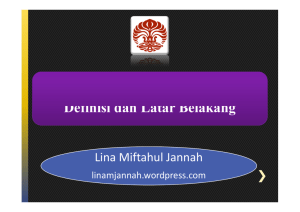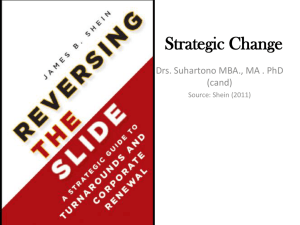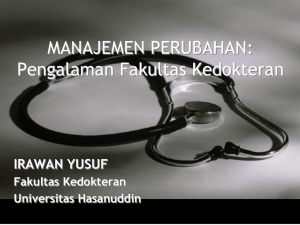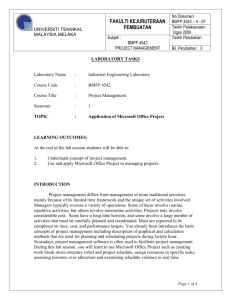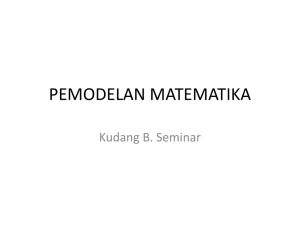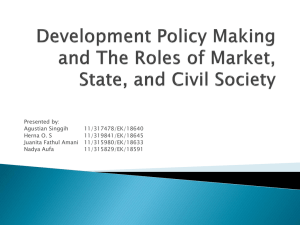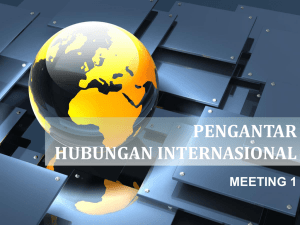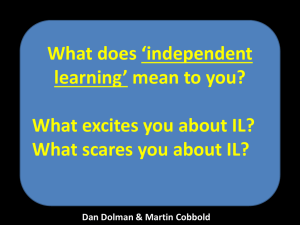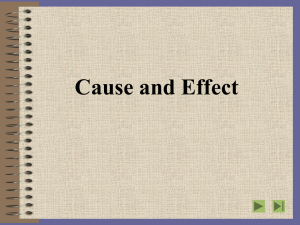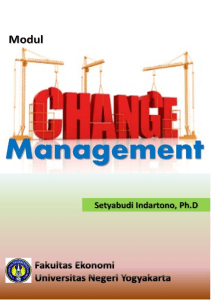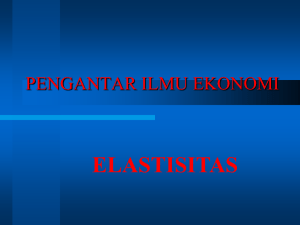MERENCANAKAN PERUBAHAN PENILAIAN KEADAAN Analisis
advertisement
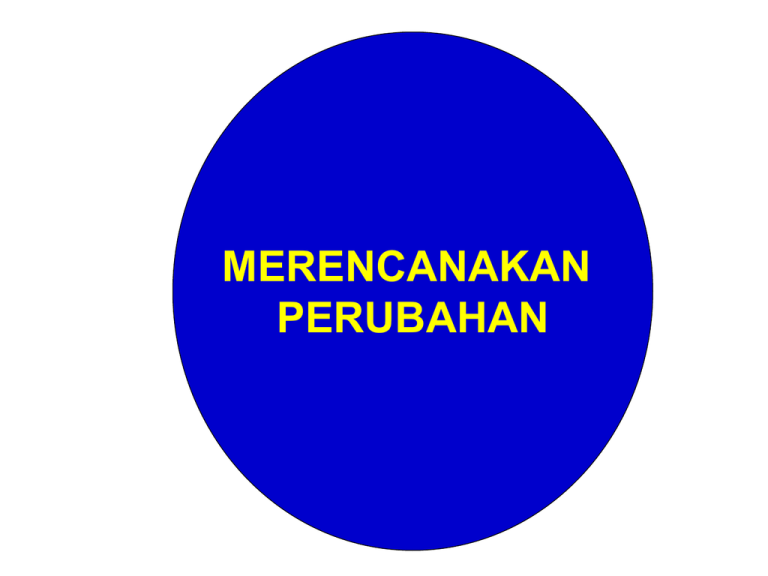
MERENCANAKAN PERUBAHAN PERSIAPAN PENCAIRAN (UNFREEZING) Menjalin dan mengembangkan hubungan PENYADARAN Menyampaikan arti penting perubahan Menumbuh-kembangkan partisipasi masyarakat (kesempatan, kemampuan dan kemauan) MERENCANAKAN PERUBAHAN PENILAIAN KEADAAN Analisis Keadaan dan Masalah Analisis Pendorong dan Penghambat Perubahan PERUMUSAN STRATEGI Analisis SWOT/TOWS PERUMUSAN PROGRAM DAN KEGIATAN METODA, LOKASI, PELAKU, WAKTU IDENTIFIKASI (JUMLAH, SUMBER)SUMBERDAYA KEKUATAN INTERNAL PELUANG EKSTERNAL KEBUTUHAN PENDORONG ANALISIS KEADAAN ALASAN STRATEGI, PROGRAM & KEGIATAN PENGHAMBAT KELEMAHAN INTERNAL ANCAMAN EKSTERNAL TUJUAN DAN SASARAN LINGKUNGAN INTERNAL: SUMBERDAYA (ALAM, SDM, INFRASTRUKTUR, KELEMBAGAAN, KULTUR) MANAJEMEN (SDM, PRODUKSI, PEMASARAN, FINANSIAL, LOGISTIK)\ LITBAG LINGKUNGAN EKSTERNAL LINGKUNGAN ORGANISASI (PELANGGAN, PEMASOK, PESAING) LINGKLUNGAN GLOBAL (TEKNOLOGI, EKONOMI, SOSBUD, KEBIJAKAN) NILAI-NILAI ORGANISASI UNTUK PERUBAHAN KARAKTERISTIK SDM TEKNOLOGI GONCANGAN EKONOMI KECENDERUNGAN SOSIAL POLITIK INTERNASIONAL DAYA SAING INTERNAL Kepemimpinan Budaya/gaya/ nilai-nilai Manajemen - Respek Anggota Kepercayaan Dukungan Partisipasi Kebersamaan Konfrontasi EXTERNAL Perubahan Global (IPOLEKSOSBUD) Kemajuan Teknologi Persaingan PARTISIPATIF CSS/PRA/PLA PAME FGD, WORKSHOP BASELINE STUDY CSS, RRA, PRA TOWS, LEGITIMASI RENCANA MONEV PARTISIPATIF (EMIK) ZOPP PERSIAPAN PENCAIRAN UNFREEZING MEDIA MASA UNTUK MEMBANGUN OPINI PUBLIK KOMUNIKASI INTERPERSONAL YANG KONVERGEN KOMUNIKASI KELOMPOK (Pertemuan Formal/Informal) COMBI (Communication for Behavioural Impact) PARTISIPASI MASYARAKAT PELIBATAN HIDDEN AGENDA SYARAT PROYEK PELIBATAN KARENA KEMAMPUAN KEARIFAN LOKAL DALAM PERUBAHAN KETERLIBATAN PARTISIPASI KESUKA RELAAN LINGKUP PROSES KEHADIRAN KETER LIBATAN BER PENDAPAT PENGAMBILAN KEPUTUSAN SELF MOBILIZATION SPONTAN INTERAKTIF KONSULTATIF FUNGSIONAL KESUKA RELAAM TERINDUKSI INSENTIF TERTEKAN INFORMATIF MANIPULATIF MENIKMATI MANFAAT LINGKUP KEGIATAN MEMBERI KORBANAN MENERIMA IMBALAN ATAS KORBANAN PENGAMBILAN KEPUTUSAN PERENCANAAN KEGIATAN PARTISIPASI PELAKSANAAN KEGIATAN MENIKMATI HASIL MONEV KEGIATAN KELOLA LINGKUNGAN KELOLA BISNIS LINGKUP PERUBAHAN PEMBERDAYAAN MASYARAKAT KELOLA KELEMBAGAAN KAPASITAS INDIVIDU PEMBERDAYAAN MASYARAKAT KAPASITAS ENTITAS KAPASITAS SISTEM/ JEJARING BELAJAR BERKELANJUTAN PEMBERDAYAAN MASYARAKAT KRITIS KREATIF SIAP MENERIMA/ MELAKUKAN PERUBAHAN PELAKSANAAN PERUBAHAN PENINGKATAN DAYA-TAWAR PEMANDIRIAN ADVOKASI FASILITASI KEGIATAN PENGEMBANGAN KAPASITAS PENGORGANISASIAN PENYADARAN MEMBANGUN OPINI PUBLIK PENGORGANI MENGGERAKKAN PERUBAHAN SASIAN MEMELIHARA SEMANGAT PERUBAHAN KEPE MIMPINAN VISIONER, TRANSFORMATIF MEMBERDAYAKAN 10 SUMBER RESISTENSI PERUBAHAN KETAKUTAN ATAS KETIDAK-TAHUAN LEPAS KENDALI KEHILANGAN MUKA KEHILANGAN KOMPETENSI KEBUTUHAN KEAMANAN KETERBATASAN WAKTU KEBIASAAN KURANGNYA DUKUNGAN KURANG PERCAYA DIRI KELAMBANAN UNTUK MENGANTISIPASI KEKUATAN PENGHAMBAT INDIVIDU PROSES SARINGAN INFORMASI KETIDAK-TAHUAN, KETAKUTAN KONDISI EKONOMI KEBIASAAN, KEAMANAN ORGANISASI ANCAMAN ALOKASI SUMBERDAYA ANCAMAN HUBUNGAN KEKUASAAN ANCAMAN STRUKTURAL/ KEAHLIAN FOKUS YANG TIDAK JELAS EDUKASI DAN KOMUNIKASI PARTISIPASI MENGATASI RESISTENSI FASILITASI DAN DUKUNGAN FASILITASI KESEPAKATAN NEGOSIASI MANIPULASI DAN KOOPTASI KOERSI/PAKSAAN IMPLISIT/EKSPLISIT MENGELOLA PERILAKU PERUBAHAN Aksi Unilateral Persuasif Yang Rasional Testimoni Keahlian Proyek-proyek Demonstarsi Pemberdayaan Pengambilan Keputusan Partisipatif Proses Kelompok KONSEKUENSI INDIVIDU: Perilaku, psikologi, dan msalah kesehatan ORGANISASI Penurunan kinerja, motivasi, moral, Peningkatan absensi dan keluar-masuk PENGENDALIAN PERUBAHAN IDENTIFIKASI DAN MOBILISASI SUMBERDAYA RAGAM: SDM, SDA, INFRASTRUKTUR, KELEMBAGAAN SUMBER/PENYEDIA: SWADAYA, PINJAMAN, HIBAH, DLL KEBUTUHAN: JUMLAH, WAKTU DAN TEMPAT THEORY DESCRIPTION SMOKING CESSATION USE LIMITATIONS HEALTH BELIEF MODEL explains and predicts health behaviors using the attitudes and beliefs toward disease, especially perceived barriers, perceived benefits, and perceived susceptibility focus messages on overcoming perceived barriers toward smoking cessation, as well as the benefits of quitting not tested as a whole, environmental or economic factors are not included, does not incorporate the influence of social norms and peer influences THEORY OF REASONED ACTION links individual beliefs, attitudes, and intentions, and assumes that behaviors are under volitional control, and intention of quitting smoking is the most important indicator of behavioral change focus messages on an individual's beliefs and attitudes to increase intention of quitting smoking does not consider environmental issues, and assumes linearity of the theory components when they may be cyclical ELABORATION LIKELIHOOD MODEL attitude change via the central route (individuals are highly motivated) is relatively permanent, resistant to counter-argument, and predictive of behavior; the peripheral route (individuals are less motivated) is less so create messages that are understandable and focused on increasing motivation and ability high motivation and high ability are necessary for a high probability of following the central route, dynamic interaction between steps, assumes people can be classified into categories STAGES OF CHANGE THEORY five stages are precontemplation, contemplation, preparation for action, action, and maintenance; no longer considered linear; rather, stages are components of a cyclical process that varies for each individual tailor messages to an individual's cyclical stage of change process doesn't account for environmental factors, presents a descriptive rather than causative explanation of behavior, each stage may not be suitable for characterizing every population Figure- Horizontal and vertical matrices capture the existing and target practices respectively The transition matrix shows considerable interference among old and new practices. Satisfaction ratings capture the importance of existing practices to stakeholders Three matrices linked together Matrix graphics have different and sometimes multiple functions. Although organizational archetypes appear stable, the transition appears to be unstable.
